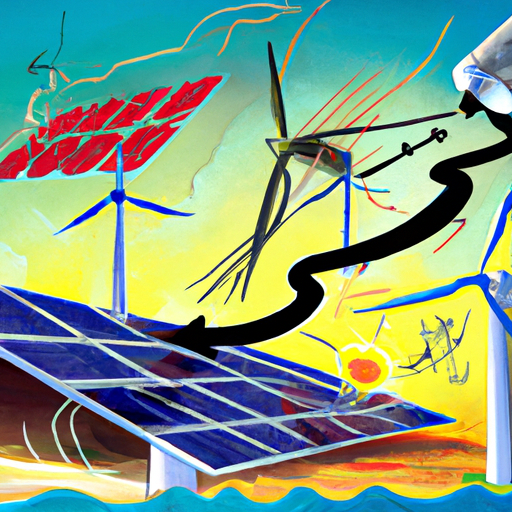Embarking on the journey to comprehend renewable energy credits can be quite an adventure! As the finest SEO copywriter, skilled in weaving magic with words, your task is not just selling ideas, but presenting them in an engaging, easy-to-understand manner. Renewable Energy Credits, in simple terms, represent proof that energy has been generated from renewable sources such as wind or solar power. They’re a trading commodity in the world of green energy. But what are these credits exactly? Rest assured, this article is here to serve as your trusted guide – not just to inform, but to offer you an enjoyable and engaging exploration into the realm of renewable energy credits.
Understanding Renewable Energy Credits
Definition of Renewable Energy Credits
Renewable Energy Credits, or RECs, represent the environmental and non-power attributes of renewable electricity production. Simply stated, they are tokens of proof that one megawatt-hour (MWh) of electricity was generated from a renewable energy source. As an easily traceable and exchangeable commodity, RECs play a vital role in accounting for renewable energy production and consumption.
The Purpose of Renewable Energy Credits
RECs serve a dual purpose. Firstly, they encourage the production and use of renewable energy such as wind, solar, and hydropower. By offering a financial incentive for businesses and individuals to switch to cleaner sources of energy, we’re together moving towards a more sustainable future. Secondly, RECs enable the tracking of renewable energy generation and use. Through RECs, parties can demonstrably show their commitment to renewable energy, which can help with green branding and compliance with regulatory standards.
Historical Overview of Renewable Energy Credits
Origin of Renewable Energy Credits
The concept of Renewable Energy Credits emerged in the late 1990s and early 2000s in response to the growing market demand for renewable energy and the necessity to track its production and use. As renewable energy represented a small fraction of the overall energy produced, RECs provided a much-needed impetus to green energy producers, rewarding them for their contributions to sustainable energy generation.
Evolution and Current Status of Renewable Energy Credits
Over the last two decades, the Renewable Energy Credits system has undergone significant transformation, evolving to accommodate various types of renewable energy sources and addressing challenges related to tracking and validation. Currently, RECs continue to be a vital tool for promoting renewable energy, with their acceptance and demand growing worldwide.

How Renewable Energy Credits Work
Principles of Renewable Energy Credits
The principle of RECs is straightforward: for every MWh of renewable energy generated, one REC is created. These RECs can be sold separately from the actual electricity produced, which allows for flexibility and market dynamism. The entity purchasing the REC can claim the environmental benefits associated with the renewable energy generation.
Process of using Renewable Energy Credits
Organizations or individuals who want to use renewable energy can purchase RECs either directly from the energy provider or through a third-party market. After purchase, the REC is “retired,” meaning it is officially accounted for and cannot be resold. It’s worth noting that buying RECs doesn’t necessarily mean that the buyer uses the renewable energy themselves, but they are supporting and paying for its production.
Types of Renewable Energy Credits
Wind Power Renewable Energy Credits
Wind power RECs are issued to entities that generate electricity using wind turbines. These RECs are generally in high demand as wind power is one of the most viable and efficient forms of renewable energy.
Solar Power Renewable Energy Credits
Solar power RECs are linked to the generation of electricity through solar panels. With the declining cost of solar technology, these RECs are becoming increasingly popular.
Hydropower Renewable Energy Credits
Hydropower RECs are generated by harnessing energy from flowing or falling water. Although less common than wind and solar RECs, they are nevertheless important, especially in regions endowed with ample water resources.

Benefits of Renewable Energy Credits
Economic Benefits of Renewable Energy Credits
For renewable energy producers, RECs represent a valuable income stream in addition to the sale of electricity. For buyers, RECs allow for the communication of their environmental commitment in a tangible manner, potentially attracting more customers or investors.
Environmental Benefits of Renewable Energy Credits
The most visible benefit of RECs is the reduced use of fossil fuels and a decrease in greenhouse gas emissions. Thus, they contribute significantly to fighting climate change and preserving our environment.
Social Benefits of Renewable Energy Credits
RECs offer tangible social benefits by encouraging the shift to a low-carbon economy. Businesses and organizations purchasing RECs can promote their commitment to sustainability, fostering a strong sense of social responsibility and underscoring their role in building a sustainable future.
Drawbacks and Challenges of Renewable Energy Credits
Potential Risks and Drawbacks
One of the criticisms of the REC system is that RECs have the potential to be ‘double-counted,’ i.e., two separate entities might claim the renewable attributes of the same energy production. Also, the purchase of RECs doesn’t always directly lead to the increase in renewable energy production.
Addressing the Challenges in the Renewable Energy Credits System
To address these challenges, robust and transparent tracking and certification systems have been implemented, such as the national tracking system in the United States called M-RETS. These systems ensure the integrity of the REC market and avoid double counting.

The Market for Renewable Energy Credits
Understanding the Market Dynamics
The market for RECs is dynamic and depends on factors such as the availability of renewable energy, legislative incentives, and corporate sustainability targets. Demand tends to increase when governmental targets for renewable energy are stringent, and there are sufficient incentives for renewable energy production.
Who are the Main Buyers?
The main buyers of RECs are businesses and organizations wishing to offset their energy consumption and portray a green image. These can range from small businesses to Fortune 500 companies, government agencies to educational institutions.
Renewable Energy Credits and Legislation
Role of Legislation in Promoting Renewable Energy Credits
Legislation plays a significant role in promoting RECs. Governments often set renewable energy targets, promoting RECs as a means for utilities to comply. In this way, policy can drive demand for RECs and stimulate the market for renewable energy.
Current legislative context surrounding Renewable Energy Credits
The legislative context surrounding RECs varies greatly by country and even by states within countries. In the United States, for instance, there are federal as well as state-level policies in place that influence the market for RECs. As renewable energy continues to gain momentum, it’s likely we’ll see an increase in supportive legislation.
The Future of Renewable Energy Credits
Predicted Market Trends
Given the global push towards renewable energy, the market for RECs is likely to observe strong growth in the coming years. Furthermore, as environmental awareness among consumers rises, businesses increasingly see the value in demonstrating their commitment to renewable energy through RECs, a trend that is likely to continue.
Impact of Technological Improvements and Innovations
Technological advancements in renewable energy generation as well as in the tracking and trading of RECs is set to make this market more accessible and efficient. Emerging technologies like blockchain may be leveraged to make the REC market more transparent and reliable.
Case Studies of Renewable Energy Credits
Effective Uses of Renewable Energy Credits
Many businesses, such as Google and Microsoft, use RECs to offset their large-scale energy consumption, effectively powering their operations with renewable energy. Additionally, universities and local governments have successfully utilized RECs to meet their sustainability goals.
Examples of Failure or Misuse of Renewable Energy Credits
Despite the successes, there have been instances of misuse. There have been cases where RECs have been sold multiple times, leading to major scandals. These instances underscore the need for robust tracking and certification systems to maintain the integrity of the REC market.
All said, despite the challenges, Renewable Energy Credits represent an effective tool for promoting renewable energy, strengthening the green economy, and fostering a sustainable future. As you consider your energy consumption and environmental impact, take note that RECs can be a useful part of your green living toolbox.
